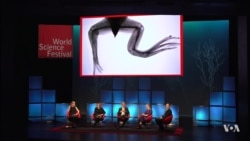Researchers are discovering clues at the cellular level that indicate human regeneration of lost body parts could be possible someday.
Imagine 3-D-printing a kidney or using bioelectricity to trigger cells to build entirely new tissue and organs. These prospects and others were discussed in "Forever Young: The Promise of Human Regeneration," a presentation during the recent World Science Festival in New York City.
Participating scientists talked about the future of regenerative medicine, which combines the human body's capacity for renewal with advances in biomedical engineering.
Dany Spencer Adams, a research professor at Tufts University, explained how introducing bioelectrical signals of varying strengths can kick-start cellular processes in tadpoles that begin the formation of nerves, muscles and ultimately limbs.
"This is the cells themselves using electricity to communicate," Adams told VOA backstage. "Hydrogen ions are positively charged, and hydrogen ions moving generates a current, and that carries information. We have created the situation where the cells will move hydrogen ions from inside the cell to outside the cell, and that signal then made an entire limb regenerate."
In one example, a frog regrew one of its legs in six months after scientists manipulated the electrical characteristics of the animal's cells.
The road ahead
Researchers still have much work to do before the findings can be directly linked to humans. A large part of the effort involves identifying which bioelectric signals correlate to the formation of any given organ. It's hoped that by studying the fundamental mechanisms of cell renewal and regeneration, the information acquired eventually will translate to medical procedures, experts said.
"It's better to regenerate that organ so that you don't have issues of the immune system attacking, the way we do now with transplants," said Adams. "The hope is that we'll be able to help the body create a better replacement — really, a perfect replacement — for the person of exactly what they've lost."
Combining mechanical engineering with developmental biology, Jonathan Butcher, a professor and biomedical engineer at Cornell University, and his team have created living, fully functioning heart valves from 3-D-printed tissue.
Child patients stand to benefit the most from such engineered organs or organ components, because they have the capacity to grow as the patient grows, Butcher said.
"You can't really use a prosthetic for that, so there's really nothing other than this kind of an opportunity. ... That's why we're pushing this envelope," he said.









